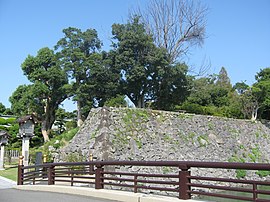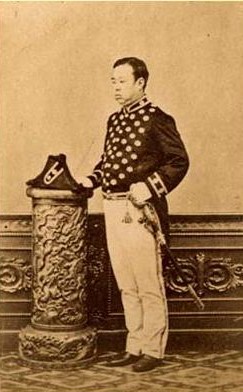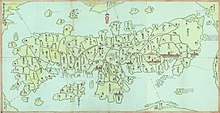
The Hosokawa clan is a Japanese samurai kin group or clan. The clan descends from the Seiwa Genji, a branch of the Minamoto clan, and ultimately from Emperor Seiwa, through the Ashikaga clan. It produced many prominent officials in the Ashikaga shogunate's administration. In the Edo period, the clan was one of the largest landholding daimyo families in Japan. The current clan head Morihiro Hosokawa served as Prime Minister of Japan.

Bungo Province was a province of Japan in the area of eastern Kyūshū, corresponding to most of modern Ōita Prefecture, except what is now the cities of Nakatsu and Usa. Bungo bordered on Hyūga to the south, Higo and Chikugo to the west, and Chikuzen and Buzen to the north. Its abbreviated form was Hōshū (豊州), although it was also called Nihō (二豊). In terms of the Gokishichidō system, Bungo was one of the provinces of the Saikaidō circuit. Under the Engishiki classification system, Bungo was ranked as one of the "superior countries" (上国) in terms of importance, and one of the "far countries" (遠国) in terms of distance from the capital.

Higo Province was an old province of Japan in the area that is today Kumamoto Prefecture on the island of Kyūshū. It was sometimes called Hishū (肥州), with Hizen Province. Higo bordered on Chikugo, Bungo, Hyūga, Ōsumi, and Satsuma Provinces.

Katō Kiyomasa was a Japanese daimyō of the Azuchi–Momoyama and Edo periods. His court title was Higo-no-kami. His name as a child was Yashamaru, and first name was Toranosuke. He was one of Hideyoshi's Seven Spears of Shizugatake.

Shimazu Yoshihisa was a powerful daimyō and the 16th Chief of Shimazu clan of Satsuma Province, the eldest son of Shimazu Takahisa. He was renowned as a great general, who managed to subjugate Kyushu through the deft maneuvering of his three brothers. Eventually, in 1585, Yoshihisa seceded control of the entire Kyushu region.
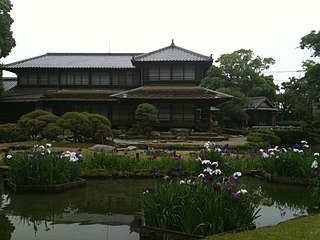
Yatsushiro is a city located in Kumamoto Prefecture, Japan. As of 1 August 2024, the city had an estimated population of 120,389 in 57953 households, and a population density of 300 persons per km2. The total area of the city is 681.29 km2 (263.05 sq mi).

The Kyūshū campaign of 1586–1587 was part of the campaigns of Toyotomi Hideyoshi who sought to dominate Japan at the end of the Sengoku period. Having subjugated much of Honshū and Shikoku, Hideyoshi turned his attention to the southernmost of the main Japanese islands, Kyūshū.

Tachibana Ginchiyo was head of the Japanese Tachibana clan and onna-musha during the Sengoku period. She was a daughter of Tachibana Dōsetsu, a powerful retainer of the Ōtomo clan. Because Dosetsu had no sons, he requested that Ginchiyo be made family head.

Fukuoka Domain was a Japanese domain of the Edo period. It was associated with Chikuzen Province in modern-day Fukuoka Prefecture on the island of Kyushu. The domain was sometimes referred to as "Chikuzen Domain" or "Kuroda Domain", named after the ruling Kuroda clan. With a kokudaka rating of 473,000 koku, the Fukuoka Domain was the fifth-largest domain in Japan, excluding those held by the Tokugawa-Matsudaira clans.

Kitsuki Domain was a feudal domain under the Tokugawa shogunate of Edo period Japan, in what is now northern Ōita Prefecture. It was centered around Kitsuki Castle in what is now the city of Kitsuki and was ruled by the fudai daimyō Nomi-Matsudaira clan for most of its history.

Hosokawa Fujitaka, also known as Hosokawa Yūsai, was a Japanese samurai lord and daimyō of the Sengoku period. Fujitaka was a prominent retainer of Ashikaga Yoshiaki, the last Ashikaga shōgun. After joining the Oda clan, Oda Nobunaga rewarded him with the fief of Tango, and he later become one of the senior generals of the Oda clan.

Kokura Domain was a feudal domain under the Tokugawa shogunate of Edo period Japan, in what is now eastern Fukuoka Prefecture. It was centered around Kokura Castle in what is now Kitakyushu, Fukuoka and was ruled by the fudai daimyō Ogasawara clan for much of its history. In the Bakumatsu period and first years of the Meiji period, it was briefly known as Kawara Domain (香春藩) and then Toyotsu Domain (豊津藩).

Hitoyoshi Domain was a Japanese domain of the Edo period. It was centered around Hitoyoshi Castle in what is now the city of Hitoyoshi, Kumamoto and was ruled by the tozama daimyō Sagara clan for all of its history.

The Kikuchi clan of Higo Province was a powerful daimyō family of Higo, Kyūshū. The lineage was renowned for valiant service in defense of the emperor and against foreign invaders. They initially distinguished themselves during the Jürchen invasion of northern Kyūshū in 1019 and rose to prominence during the Mongol invasions of Japan when the heroism of Kikuchi Takefusa helped drive back the enemy. The Kikuchi was active in the Kenmu Restoration (1333-1336), an attempt by the emperor Go-Daigo to reassert imperial authority against the Kamakura shogunate.
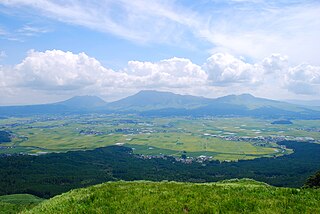
The history of Kumamoto Prefecture has been documented from paleolithic times to the present. Kumamoto Prefecture is the eastern half of Hinokuni, and corresponds to what was once called Higo Province. Exceptions are the parts of Kuma District, which had once been part of Sagara Domain, and Nagashima which was included in Kagoshima Prefecture.

Kitsuki Castle is an Edo period yamajiro-style Japanese castle located in the city of Kitsuki, Ōita Prefecture, Japan. Its ruins have been protected as a National Historic Site since 2020. The current castle, a replica tenshu built in 1970, is considered to be the smallest castle in Japan.

The Bungo Kaidō (豊後街道) was a route built during the Edo period in Japan. It started in Kumamoto, Higo Province, and stretched to Ōita, Bungo Province. There were six post stations along the route connecting the two cities.

Tanaka Castle was a Sengoku period Japanese castle located in the town of Nagomi, Kumamoto Prefecture, Japan Its ruins have been protected as a National Historic Site since 2002.
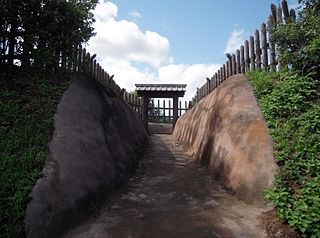
Uto Castle was a Sengoku period flatland-style Japanese castle located in the present-day Furushiro-cho neighborhood of the city of Uto, Kumamoto Prefecture, Japan. Its ruins have been protected as a National Historic Site since 2020.
Sashiki Castle was a Sengoku period yamajiro-style Japanese castle located in the town of Ashikita, Kumamoto Prefecture, Japan. Its ruins have been protected as a National Historic Site since 2008. It is also referred to as Sashiki Hanaoka Castle.



